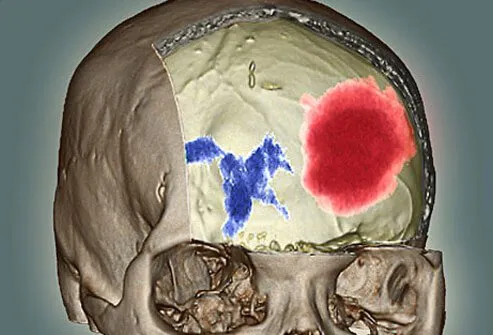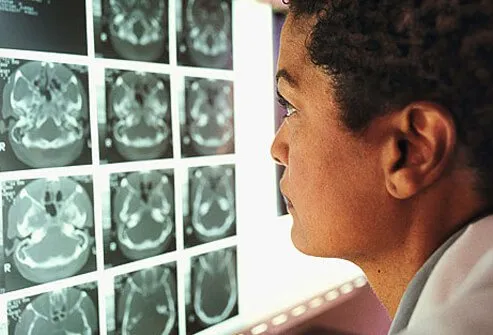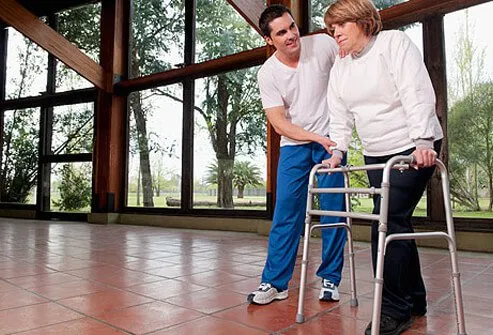Head Injuries and Your Brain

Although the brain is protected by tough bone (skull) and padding (membranes), it can still be injured. Head injuries that are severe enough to affect brain function are termed traumatic brain injuries (TBIs). Damage can range from mild to severe as the brain can affect everything you do.
How Your Brain Can Get Injured

Traumatic brain injuries result from either a blow to the head that does not penetrate the skull (closed head injury) or from an object penetrating through the skull into brain tissues (open brain injury). However, there are variations of these general terms in the medical literature so people may not agree on all points (For example, is a depression of the bony skull toward the brain an open or closed brain injury?). Consult your doctor about the type of head injury.
Mild vs. Severe TBI’s

A concussion is considered a milder form of a traumatic brain injury (closed brain injury) by most clinicians. In most people, recovery from a mild concussion is quick. However, if the person suffers a severe concussion, the person may be unconscious for a long time period. Some people develop comas or even die from this type of closed head injury.
What is a Concussion?

The slide illustrates how a blow to one side of the head throws your brain back toward the opposite side thus potentially causing damage to both sides of the brain. This leads to a concussion or closed brain injury that can cause mild or serious symptoms. A concussion is defined as a blow to the head that results in disturbance of cerebral function. Concussions are the most common type of traumatic brain injury and can, in more severe injuries, cause permanent brain damage. The majority of concussions cause minor or no obvious lasting damage if the brain is allowed time to heal.
How Do You Know It's a Concussion?

Signs of a concussion occur after the traumatic brain injury and may include one or more of the following:
- Loss of consciousness
- Not remembering the blow to the head
- Dizziness
- Blurry vision
- Headache
- Nausea and/or vomiting
- Unclear thinking processes (confusion)
- Repeating phrases (for example asking, "What happened?" many times)
Healing After a Concussion

A person can recover from a concussion. Recovery depends on the amount of damage. If areas of the brain are injured but not destroyed, the recovery is like healing from an ankle sprain. You give it good rest and slowly use it until full healing has occurred. If you do not allow your ankle to heal and it gets sprained again, the ankle can suffer permanent damage. The same is true for your brain tissue. Consult your doctor about how long you should wait before doing activities that put you at risk for another concussion (boxing, football, judo, or similar activities).
Skull Fractures

Although the skull is like a helmet that protects the brain tissues, it can be cracked, dented, and penetrated with enough force. Sharp bone fragments of the skull can then press into the brain. This can result in brain tissue damage or brain tissue death and may also cause bleeding into the brain. If after a person sustains head trauma and has clear fluid or a bloody discharge from the ears or nose, a skull fracture should be suspected.
Bleeding in the Brain

Bleeding inside the brain is a medical emergency. The blood, under pressure, has no place to drain so it often pools and forms a hematoma. The hematoma can put pressure on the surrounding tissue and squeeze off the blood supply to parts of the brain. Signs of a hematoma include headaches, vomiting, and loss or decrease in normal balance.
Diagnosing Brain Injuries

A doctor begins to get evidence for diagnosing a traumatic brain injury first by getting a history and doing a physical exam that focuses on brain functions such as memory, concentration, and problem solving behavior. The doctor may also interview close family members or friends to determine if they have noticed any changes in the patient. A head CT (computed tomography) or, occasionally, an MRI (magnetic resonance imaging) of the head is often done to definitively diagnose and obtain evidence of the extent of a traumatic brain injury.
Brain Injuries and Memory

Memory is often damaged when a traumatic brain injury occurs. Mild traumatic brain injuries may have little or no effect on memory. If there is an effect, the memories lost may be recent (for example, no recall of the traumatic event) and quickly return in hours or days. However, more severe traumatic brain injuries can cause loss of memories for long time periods (weeks, months, or longer). Sometimes some memories may never return.
Brain Injuries and Movement

A common effect of a traumatic brain injury is damage or loss of balance and feeling dizzy. Some individuals lose visual depth perception. Depending on the severity of the traumatic brain injury, the problems may last seconds, minutes, or lifelong. Rehabilitation techniques, similar to those used for stroke patients, can help individuals improve balance and regain many aspects of normal life.
Brain Injuries and Mood

Brain functions impact how a person behaves and feels. Consequently, a traumatic brain injury can cause behavioral and mood changes. Agitation, depression, insomnia, mood swings, and feeling like you are not your normal self are common occurrences (some investigators estimate 50%) after traumatic brain injuries. Although these problems may resolve quickly, some patients may have these problems for extended time periods. Such problems should be discussed with your doctor because there may be readily available treatments for these problems.
Long-Term Effects of Brain Injuries

Unfortunately, serious traumatic brain injuries can result in increased risk for other brain disorders. There is some evidence that traumatic brain injuries increase the person’s risk for Parkinson’s disease and Alzheimer’s disease. In addition, repeated minor traumatic brain injuries that show little or no significant symptoms like those that may occur in football players or boxers may result in the same risks because lots of small damage may be cumulative over time.
Recovery from Severe Brain Injury

Recovery from severe traumatic brain injuries usually requires the injured person to have help from professionals. Physical, occupational, and/or speech therapists are helpful and allow the person to recover some or most of their normal life functions (for example, walking, fine motor control like using a pencil, or improved verbal communication). A psychiatrist or a psychologist can also help with mental and behavioral problems.
How Common Are Brain Injuries?

Traumatic brain injuries are common. About 1.4 million occur per year and about twice as many males have traumatic brain injuries. The highest risk groups are infants and children (ages 0 to 4), and ages 15 to 19 while adults aged 75 and older have the highest rates of hospitalization and death. About 75% of all traumatic brain injuries are mild concussions. The four major causes of traumatic brain injuries are falls (28%), vehicle crashes (20%), object striking the head (19%), and assaults (11%).
Children and Brain Injuries

Traumatic brain injuries often occur in infants and children (about 475,000 per year). Like adults, children can and some do get symptoms that present as learning, behavioral, and emotional problems. Some problems include hearing, speech, vision, and balance problems plus headaches and even seizures. Essentially, the problems seen in adults with traumatic brain injuries can be seen in children but sometimes the problems do not show up or are not noticed for months or years. The children often do not grow out of problems caused by traumatic brain injury. Many children may need professional help to address their problems.
Just a Bump on the Head?

Unfortunately, infants and especially toddlers learning how to walk (or run!) frequently fall and bump their heads. Most of these bumps don't cause traumatic brain injuries. However, if the child will not stop crying, is vomiting, can't move around normally (walk), and says their head and/or neck hurts or is difficult to wake up, the child needs to be evaluated emergently by a doctor.
Bike Safety

If your child rides a bicycle or engages in other sports (football, baseball, motorbike, ATV, and other) where a blow to the head may occur, the best thing you can do to protect them from traumatic brain injuries is to get them a well-fitted helmet and instruct them in the rules of the road.
Head Injuries from Sports

As mentioned previously, a well-fitted helmet currently offers some protection against traumatic brain injuries in many sports, from professional sports to kids playing games like little league baseball or girls softball. Professional sports managers are constantly changing rules of play and advancing equipment designs to reduce the chance of traumatic brain injuries. Following the rules and using up-to-date equipment may reduce the incidence of sports-related traumatic brain injuries seen in kids up to and including professional sports players.
Cars Safety

Car accidents are a leading cause of traumatic brain injuries in adults and children. Preventive measures can reduce both the incidence and severity of traumatic brain injuries in both children and adults. Before even starting any vehicle, every child and adult should be buckled in their seatbelt. Small children need to be in their age/weight appropriate car seat.
Preventing Head Injuries from Falls

Falls are the number one cause of traumatic brain injuries, especially in older adults. People do not have to fall from a height like falling off a ladder. Simply falling from a standing position and hitting your head can cause severe traumatic brain injuries in some people. Reducing the risk of falls, especially at home or at work, can help avoid traumatic brain injuries. Preventing falls involves installing good lighting on stairs and hallways and removing obstacles like toys, clothing, or tools on the floor or electrical cords that can trip people. Throw rugs need to be skid resistant or removed to avoid trips and slips that lead to falls. Reasonable precautions that are easy to do may prevent many falls that cause traumatic brain injuries.
Concussions & Brain Injuries: Symptoms, Tests, Treatment
This tool does not provide medical advice. See additional information: 
© 1996-2024 WebMD, LLC. All rights reserved.
